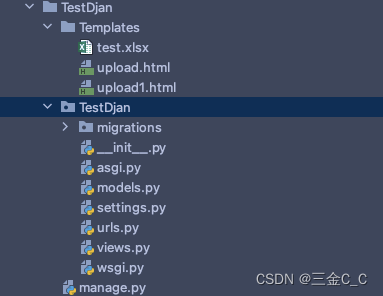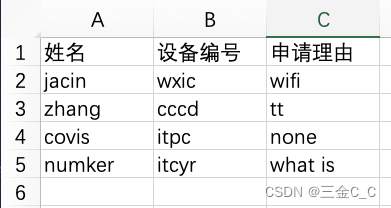在web开发中,难免会遇到批量导入信息的操作。一般来说,给一个excel模版然后自己在本地填写完成后提交,并上传到对应的数据库中。在此之前,我也看了不少人的代码,但是运行起来都或多或少存在问题,所以索性写了这篇博客,以供参考和学习。
当然在上传到数据库中后需要对表的内容进行对比,然后筛选出相应的内容,这将是我后面需要写的内容了,这一部分其实没什么好说的了,就是简单的读,可以使用多种方法来进行。
关于django-admin startprocject项目等架构,包括设置settings.py和ORM建表命令等请参考我之前的博客内容,不再做过多的阐释了。这是我的测试项目文件目录。

在视图部分,建了跳转页面与上传文件的视图函数,在视图函数中也包含了对数据库的操作(见models.py)
需要上传的excel文件,注意格式是 xlsx

views.py 注意xlrd需要下载1.2.0,如果版本过高存在无法读取xlrd的情况。其中为了方便,我在中途打印了里面的数据,以测试是否正常。
import xlrd
from django.db import transaction
from django.shortcuts import render,HttpResponse,redirect
from TestDjan import models
def upload(request):
return render(request,"upload.html")
def excel_upload(request):
if request.method == "POST":
file=request.FILES['my_file']
print(file)
type_file = file.name.split('.')[1]
print(type_file)
if type_file == 'xlsx':
read_file = xlrd.open_workbook(filename=None,file_contents=file.read())
file_table = read_file.sheets()[0]
print(file_table)
file_table_rows = file_table.nrows
print(file_table_rows)
try:
with transaction.atomic():
# 读表格数据,从第二行开始,一般第一行都是说明
for i in range(1,file_table_rows):
print(i)
a=file_table.cell(i,0)
print(a.value)
b= file_table.cell(i,1)
print(b.value)
c=file_table.cell(i,2)
print(c.value)
models.test_excel_info.objects.create(name=a.value,pcnum=b.value,cause=c.value)
except Exception as e:
return render(request,"upload1.html",{'msg':e})
return render(request,"upload1.html",{'msg':"suss"})
return HttpResponse(render(request,"upload1.html",{'msg':"no"}))
return HttpResponse(render(request,"upload1.html",{'msg':"none"}))
models.py ,这里是简单的一个表结构,不要忘记使用建表命令。
from django.db import models
class test_excel_info(models.Model):
name = models.CharField('名称',max_length=20)
pcnum = models.CharField('电脑编号',max_length=30)
cause = models.CharField('理由',max_length=30)
urls.py
path('upload/',views.upload),
path('upload1',views.excel_upload),
下面是简单的前端测试代码:
upload.html,这是此页面

<!DOCTYPE html>
<html lang="en">
<head>
<meta charset="UTF-8">
<title>Title</title>
</head>
<body>
<form action="/upload1" method="post" enctype="multipart/form-data">
{% csrf_token %}
<input type="file" name="my_file">
<input type="submit" value="提交">
</form>
<a href="/download_template" >点击下载模版文件</a>
</body>
</html>
选择浏览文件,点击上传后的页面,符合前面的逻辑。

upload1.html
<!DOCTYPE html>
<html lang="en">
<head>
<meta charset="UTF-8">
<title>Title</title>
</head>
<body>
{{ msg }}
</body>
</html>
进入到suss说明已经成功了,可以选择在数据库中查看是否已经导入完毕:

当然了,这是上传的excel工作,为了保证实际工作中不引起格式的混乱,将在前端页面中展示相应的下载模版文件选项。
views.py
def download_template(request):
file = open('Templates/test.xlsx', 'rb') # 路径不要写错了。
response = FileResponse(file)
response['Content-Type'] = 'application/octet-stream'
response['Content-Disposition'] = 'attachment;filename="test.xlsx"'
return response
urls.py
path('download_template/',views.download_template),
前端页面也在upload.html给出。
以上就是在django框架体系中对excel下载与上传内容。